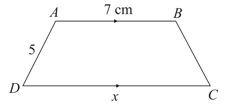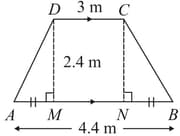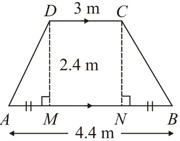O P Malhotra, S K Gupta and, Anubhuti Gangal Solutions for Exercise 4: Exercise
O P Malhotra Mathematics Solutions for Exercise - O P Malhotra, S K Gupta and, Anubhuti Gangal Solutions for Exercise 4: Exercise
Attempt the practice questions from Exercise 4: Exercise with hints and solutions to strengthen your understanding. ICSE Mathematics solutions are prepared by Experienced Embibe Experts.
Questions from O P Malhotra, S K Gupta and, Anubhuti Gangal Solutions for Exercise 4: Exercise with Hints & Solutions
The area of a trapezium is and the height is . Find its two parallel sides if one side is greater than the other.
The parallel sides of a trapezium are in the ratio and the distance between the parallel sides is . If the area of the trapezium is , find the lengths of its parallel sides.
In the given figure, The parallel sides are apart. . Find and the area of the trapezium .

The parallel sides of a trapezium are ; and the other sides are each . Find its area.
The cross-section of a tunnel perpendicular to its length is a trapezium as shown in the figure . The height of the tunnel is . The tunnel is long.

Calculate the cost of painting the internal surface of the tunnel (excluding the floor) at the rate of
The cross-section of a tunnel perpendicular to its length is a trapezium as shown in the figure . The height of the tunnel is . The tunnel is long.

Calculate the cost of paving the floor (in)at the rate of .
A trapezium with its parallel sides in the ratio is cut off from a rectangle whose sides measure and . The area of the trapezium is of the area of the rectangle. Find the lengths of the parallel sides of the trapezium, when its height is equal to the smaller side of the rectangle.
The cross-section of a canal is in the shape of a trapezium. If the canal is wide at the top and wide at the bottom and the area of its cross-section is , determine its depth.
